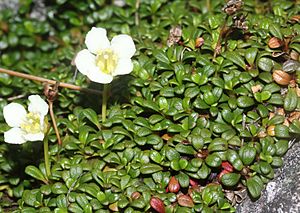Pincushion plant facts for kids
Quick facts for kids Pincushion plant |
|
|---|---|
 |
|
| Diapensia lapponica subsp. obovata in Japan | |
| Scientific classification | |
| Genus: |
Diapensia
|
| Species: |
lapponica
|
| Subspecies | |
|
|
The Diapensia lapponica, also known as the pincushion plant, is a small, tough plant found in cold, northern parts of the world. It belongs to the Diapensiaceae family. This plant is special because it's the only type of Diapensia that grows all around the Arctic and northern regions. Other plants in its family usually live in the Himalayas and mountains in China.
This plant likely moved to the Arctic from North China and Russia a long time ago. It probably came from a white-flowered plant called D. purpurea. Pincushion plants grow on exposed, rocky ridges where strong winds blow away the snow.
Contents
About the Pincushion Plant
Diapensia lapponica grows very slowly and stays low to the ground. It can't compete with taller plants that might grow over it. This plant is very sensitive to warmer temperatures. It often prefers misty and foggy places. It usually dies if you try to move it to a garden in a warmer, lower area, so it's best not to try. However, if you collect its seeds in winter or treat them with cold, they can sprout indoors. The seeds and leaves of this plant have a lot of fats.
It is a small, evergreen plant that forms a cushion shape. It grows up to 15 centimeters (about 6 inches) tall. This cushion shape helps it trap heat. It has oval, blunt, leathery leaves that are about 1 centimeter (0.4 inches) long. These leaves grow in tight groups called rosettes. The plant has single white flowers, which are sometimes pink. These flowers grow on stems up to 3 centimeters (1.2 inches) tall.
Scientists can figure out how old a pincushion plant is by counting its growth rings or measuring how wide its clump is. Many plants in Canada are thought to live for more than one or two centuries using this method.
Life Cycle and Reproduction
In some places, like Newfoundland, the pincushion plant can bloom at two different times of the year. It might flower in early June and then again in August. Scientists are not sure if this happens because of the plant's genes or because of its environment. Other plants are also known to have two blooming periods. This often happens when flower buds form in the current year or the year before and survive the winter.
Types of Pincushion Plants
There are two main types, or subspecies, of Diapensia lapponica:
- Diapensia lapponica subspecies lapponica: This type is found in eastern North America, Greenland, Iceland, Scotland, Scandinavia, and western Arctic Russia. It grows in dense clumps. Its leaves are oblong to narrowly spoon-shaped.
- Diapensia lapponica subspecies obovata: This type is found in eastern Arctic Russia, Korea, Japan, Alaska, and the Yukon. It forms mats because its branches can grow roots as they spread. Its leaves are egg-shaped with the wider part at the end, or spoon-shaped.
The areas where these two subspecies grow do not meet in north-central Canada or possibly in central Siberia. This suggests that they spread east and west from different areas where they survived during the Ice Age.
Where the Name Comes From
The famous scientist Carl Linnaeus gave the name Diapensia lapponica to this flower. He found it in Lapland, a region in northern Europe, during his travels. Linnaeus wrote a book about the plants of Lapland, which was very important for its time.
The meaning of the genus name, Diapensia, is a bit of a mystery. Some experts think it might come from an old Greek name for a different plant. Others suggest it might relate to the plant's five-part flower structure. One idea even suggests it means "deeply grieving," perhaps because of where the plant grows.
Status in Britain
In Great Britain, the pincushion plant is found in only one place. This site is near Glenfinnan in Lochaber, Scotland. It is the southernmost place in Europe where this plant grows. Here, it lives on rocky, acidic soil on a ridge between two hills, about 760 to 780 meters (2,500 to 2,560 feet) above sea level. The total area where it grows is less than 5,000 square meters (about 1.2 acres).
About 1,200 clumps of the plant have been counted at this site. Monitoring since 1980 shows that this population has not changed much.
The Diapensia plant was discovered in Scotland in July 1951 by a birdwatcher named C. F. Tebbutt. He recognized it as something unusual. This discovery was one of three rare Arctic plants found in Scotland in the early 1950s. Before this, no new plant species had been found in Scotland since the Victorian era.
At this Scottish site, the plant flowers in May or June, but the exact time changes each year. The plant is listed as "vulnerable" in the British plant Red Data Book. It is also protected by law under the Wildlife and Countryside Act 1981.

